Lest we forget: Civil War reenactors provide a living history.
As Ron McGovern, wearing his Civil War captain’s uniform replete with brass buttons and sword, sat in a pew at St. Patrick’s Old Cathedral in New York’s Little Italy a few years ago, he couldn’t help feeling “a little time transport.” The church organist pumped Mozart’s Requiem into a space filled with members of the Irish Brigade of the 69th New York Regiment, and a requiem mass was being celebrated, similar to one held 135 years earlier, in 1863, for members of the Irish Brigade who had been killed in battle.
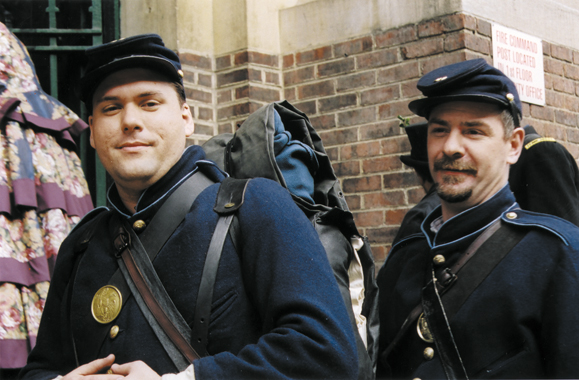
In everyday life, McGovern, 42, is a credit analyst, an Army reservist, and a new father. But as he sat in that church he thought about his County Cork ancestors who had come to live in this neighborhood of lower Manhattan in the 19th century, and all of the Irish who had joined the battle for a land that had not yet made them welcome.
McGovern and 30 other men in Company A of the 69th New York State Volunteers – the Irish Brigade – are Civil War reenactors. They’re also cops and firemen, lawyers and stock brokers, carpenters and teachers. There is a farmer from Pennsylvania and an independent filmmaker. The average age is mid-thirties, but until recently they included a World War II veteran, who finally, at 75, decided he’d had enough of camping out in muddy battlefields.
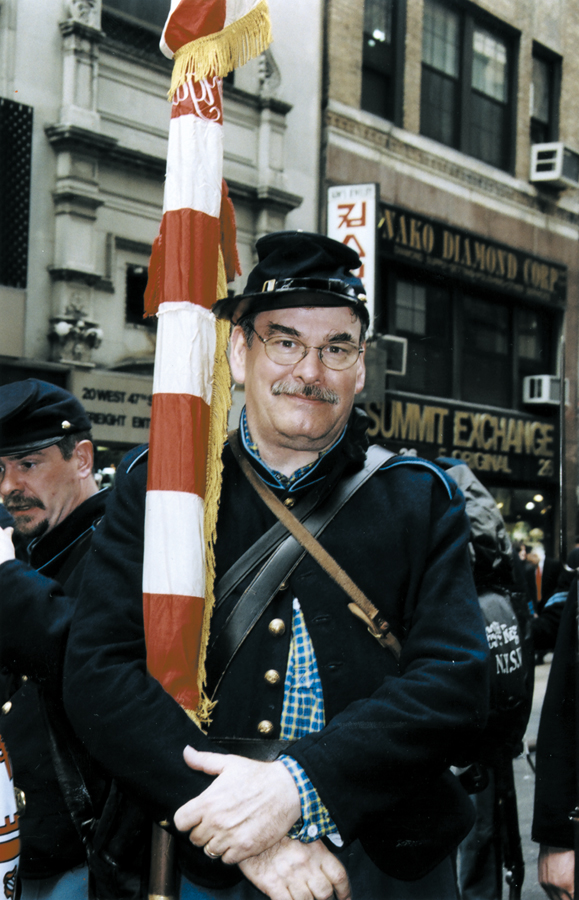
Company A was organized in 1992 by McGovern and a few others from a loosely knit band of Irish groups known as the Irish Brigade Association. They met at Fort Schuyler, in the Bronx, where the original Irish Brigade was organized in 1861 and proposed a Civil War reenactment group for the 69th New York. McGovern thought it would be a good chance to educate the public about the role of the Irish in the Civil War. They hold drills at the 69th Regiment Armory on Lexington Avenue and 26th Street, a national landmark building and home to the Fighting 69th. Their clubhouse at the Armory, The Garyowen, contains a bar, and is a mini-museum operated by Vic Olney.
The original Irish Brigade was organized by Brigadier General Thomas Francis Meagher, who came from County Waterford. He began recruiting Irish volunteers who eventually formed the 69th, the 63rd, and 88th New York. Throughout the war the Irish Brigade was usually in the front of the battle lines and suffered high casualties.
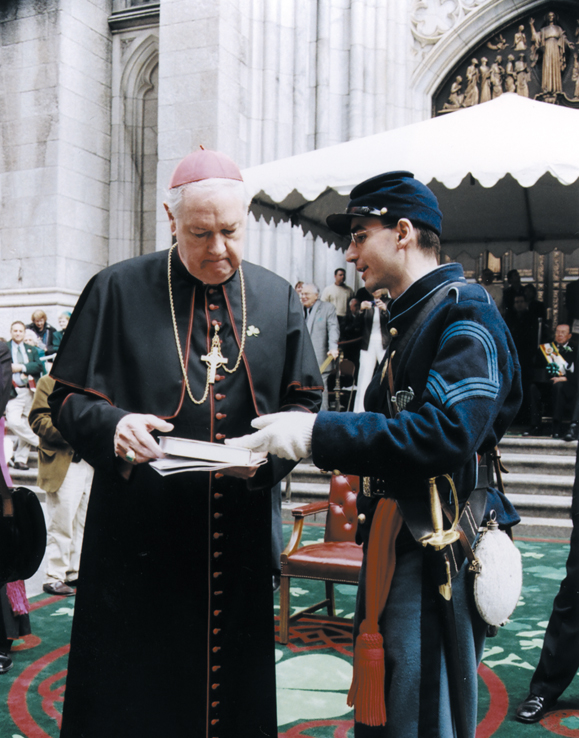
The Irish Brigade was known as the most convivial camp in the Army of the Potomac. Officers and recruits from other units wangled invitations into their camp where there was plenty of Irish whiskey and beer, card games and horse and donkey races. The conviviality continues.
“Our group is known for having a good time,” McGovern said. Robert Carter, a 34-year old law student, said about his colleagues, “they know history and they know how to have fun. I would be friends with these guys even if they were not into the hobby.” In addition to reenactments and living histories at Civil War sites and cemeteries, they enjoy festive occasions like their annual pig roast at the Adams City Irish Fair.
But these reenactors set a high standard for authenticity. Carter chairs the Authenticity Committee, which issues 40-page guidelines on “kit” – uniform, weapons, food and personal items the soldier carries. For example, toothbrushes of bone and bristle were often carried prominently in the headband of their caps, as was a sprig of boxwood to represent the Irish Brigade (see sidebar). Some soldiers carried pipes, Bibles, rosaries, playing cards or dice. McGovern, as a commissioned officer, carries paperwork and sometimes a replica newspaper. When they participate in a reenactment, the men carry hard tack and salt pork. Carter makes his ahead of time by cutting pork into strips, frying or baking it and storing it in a cloth sack.
“I lived on it for two and a half days like the originals did,” he recalls, adding that “Woolen uniforms are not comfortable in 90-degree heat, but when wearing two-button flannel drawers, chafing and itching is reduced.” It’s deemed okay for reenactors to carry modern medications but they must be hidden inside a tobacco tin or pouch. They cannot wear a wristwatch, carry keys, or wear modern eyeglasses. They even clean their uniforms with soap on a washboard, the authentic way. “Some guys don’t clean them at all,” McGovern said, “because they believe that was how the soldiers lived in the field.” Nobody takes them to the dry cleaner.
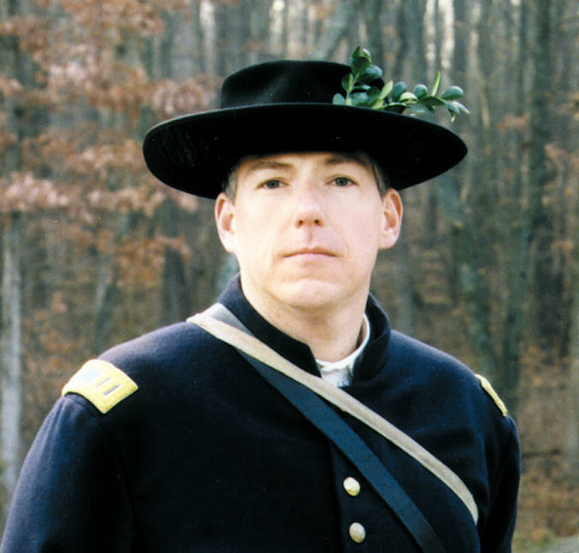
On the battlefield they roll out a blanket on top of a sheet of rubber, and shelter themselves with a half tent. “You button your sheet to your comrade’s,” Carter explained. “I remember Shiloh. We had three and a half inches of rain in three hours. Mud was ten inches deep. We talk about it as fun – we suffer together.” “Recreating the experience includes the discomfort,” McGovern said.
Jim Madden, 38, a political consultant for New Jersey Democrats, believes “the reenacting movement has become more authentic in recent years.” He and his two brothers are involved, and with his brother Gerald, he helped McGovern organize Company A.
Carter, whose family name is Cartusciello, is probably the only brigade member who is not ethnically authentic. He considers himself “adopted Irish.” Most of the others can trace their ancestry to the early Irish immigrants in New York and a few have been to Ireland to see where their ancestors came from. McGovern and his wife, Eileen, visited his ancestral home in County Cork and then Tipperary, where her ancestors came from. Although Carter’s ancestors are Italian, he dated a girl who was interested in Irish history and he took a trip to Dublin with her.
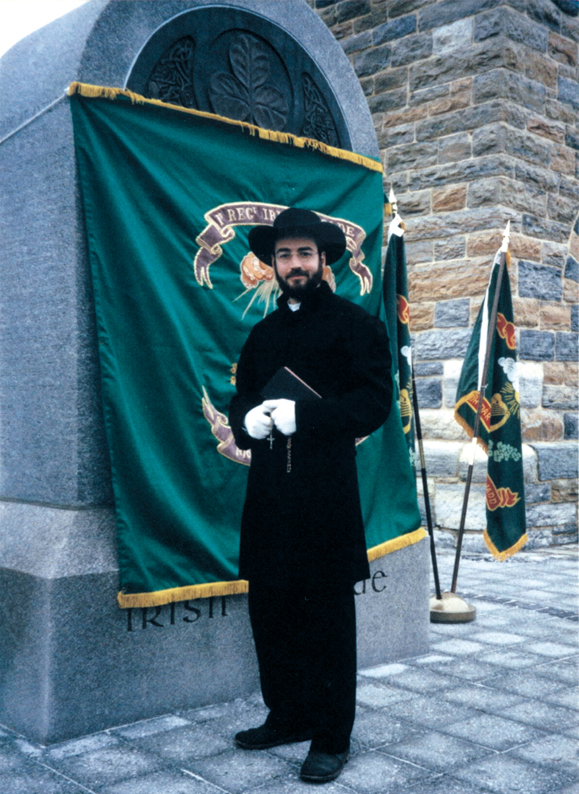
“Our guys can bend your ear for 45 minutes on any aspect of the Civil War,” Carter said. “They’re read it all.” And in most cases this passion for history began early.
Kevin Ryan, 29, who hopes to get into the Fire Department of New York, has a great grandfather from Tipperary. He said history was his favorite subject in Iona College, and one professor really got him interested. Others had similar experiences. In the fifth grade, McGovern was inspired by a teacher who was “all fired up” about the Civil War.
Madden and his brothers used to take summer trips with their parents to places like Gettysburg and that obviously made an impression. His father’s family was from County Mayo and he grew up listening to Irish radio and going to Irish parades. His interest in the history blossomed in high school and continued through St. Peter’s College. Some friends who were reenactors invited him to “suit up and try it out.” During the 1980s he did lots of traveling with New Jersey reenacting groups. Almost every weekend they formed car pools, drove all night, set up camp, and “woke up with hundreds of guys in uniform.”
As a kid Carter lived in Washington, D.C. and remembers touring Bull Run. He was so impressed that he began giving informal tours of the site to his friends who suggested he join the reenactors. The more he learned, the more he realized, “I gotta do this.” Following his first meeting at the 69th NYSV, he began assuming the role of chaplain and continued for three years while he was a Jesuit seminarian. In 1999 he left the Jesuits to study law, but asked permission to continue in the role as the chaplain he had carefully researched.
McGovern remembers watching the James Cagney movie The Fighting 69th with his dad. Always a voracious reader, he ploughed through all the books on Civil War generals. However, when his mother asked him what he thought it was like for the average guy, he decided to check out local reenactment groups in Staten Island and Brooklyn. At 17 he was ready to join in. While his parents said they would support him, he would have to take the initiative for what is an expensive hobby. The basic soldier’s kit can cost as much as $2,000. McGovern got a summer maintenance job at his parish school. “My first purchases were somewhat humble,” he recalls, “items I wouldn’t be able to borrow from others, such as the shoes and the trousers of an infantryman.” His family bought him a musket and his mess equipment for birthdays and Christmas. Over the years he acquired a considerable collection. Another expense was a special wardrobe from Home Depot in which to keep it all.
Carter, who considers himself a hardcore reenactor, is completely outfitted with a chaplain’s kit, and he can portray a union private or officer at any time of the war.” (He can also do a Confederate.) Part of his closet at home, as well as a trunk and carpetbag hold all his gear. Like the original soldier, he brings to the reenactment only what can be carried on his back. (He does, however, drive to the site, and stows his kit in the backseat of his car.)
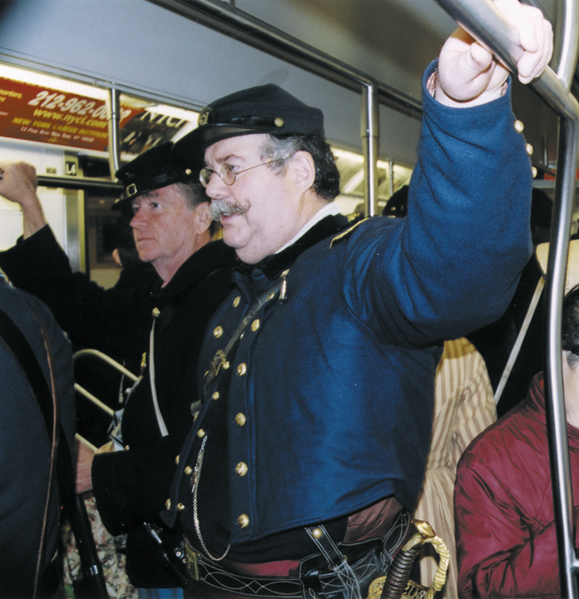
What reenactors do by putting on the uniforms and going through the motions of battle, is get to know who the Civil War soldiers were and how they felt. Carter says there is one standard for the brigade: “What did the old guys do? How do we honor their memory?”
When they organized in 1992, the reenactors began a project to honor the fallen at Calvary Cemetery in Queens where so many from the Irish Brigade are buried. They began to repair and restore the headstones with the financial help of a local undertaker.
“We carry on the memory of what these guys did,” Carter said. On a cross country trip he stopped at Notre Dame to put flowers on the grave of Father William Corby, chaplain of the Irish Brigade and later president of Notre Dame College. Carter has portrayed the chaplain so often, he feels a special bond.
When they recently began decorating graves of Irish Brigade members at Gettysburg, McGovern discovered that one of the soldiers had lived near the site of his office in lower Manhattan. He went for a walk around the area to locate where the soldier had lived and to pay tribute.
The Brigade has appeared in a documentary on Calvary produced by the National Park Service that is designed to give visitors an idea of the cemetery’s Civil War history. A similar documentary on Fredericksburg was made with these men reenacting the Irish Brigade’s role.
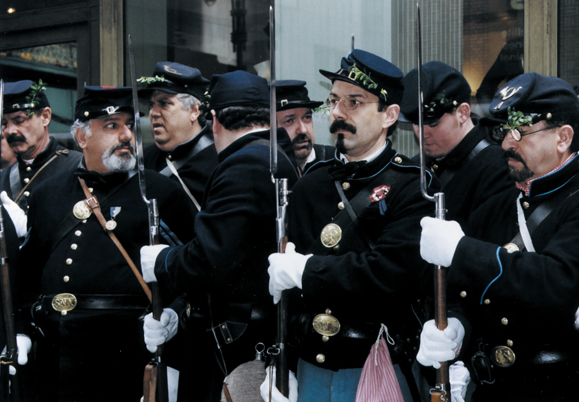
A beautiful hand-embroidered green silk flag attracted many new recruits in the early days of Company A. The flag is an exact replica of the original carried into battle in the Civil War. “It is the most impressive part of the unit,” Madden said, describing their march in a Monmouth, New Jersey parade in 1992. Many people who saw the flag on that day called wanting to join the group. However, the origin of the modern flag is a bit of a mystery. According to Madden, it was made by the girlfriend of one of the reenactors but when the couple later broke up, the flag stayed with the reenactor.
The flag was restored for this year’s St. Patrick’s Day Parade, a very special event for this group, which serves as the honor guard for County Waterford, the home town of the Brigade’s leader General Francis Meagher. After suiting up at the Armory, they get on the Lexington Avenue subway for the ride uptown to join the parade. It amuses McGovern that New York City subway riders accept the presence of a Civil War brigade without showing much surprise.
A monument to the Irish Brigade at Antietam battlefield in Sharpsburg, Maryland was dedicated in October of 1997. Irish Brigade reenactors were joined by other units from the 69th New York, along with scores of dignitaries including the Ambassador of Ireland.
“We were on the spot of the field known as the Sunken Road where the Irish Brigade attacked the center of the Confederate line,” recalled Carter who had grown out his beard to be authentic in his chaplain’s uniform of black frock coat, black pants, and civilian hat. He was serving as acolyte to the archbishop, who turned to him and asked “Do you think we’re ready to go?”
At that moment “a huge flock of honking wild geese came right out of nowhere and flew about 40 or 50 feet over our heads. They came from behind the crowd, flew directly over us and the monument, crossed the Roulette Farm and disappeared. You could have heard a pin drop as the entire crowd turned to one another scarcely believing what they had just seen. The significance of the moment was not lost on anyone.”
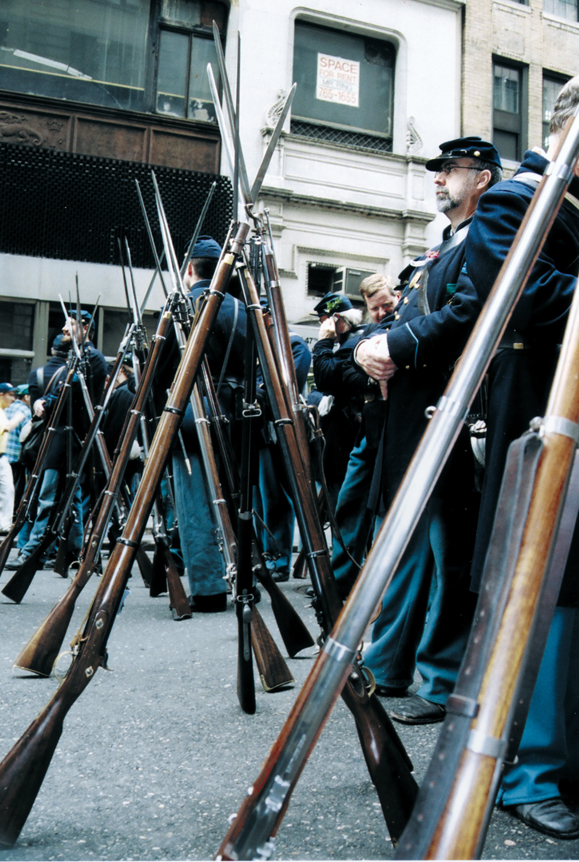
Carter said that later, when the reenactors headed to nearby Hagerstown for dinner, “everyone talked about the geese, especially since we hadn’t seen a single bird for the rest of the day! We called it the Irish Brigade flyover.” (The Wild Geese is a term used for soldiers who left Ireland for France after the Treaty of Limerick was broken in 1691). McGovern wasn’t ready to acknowledge a mystical connection. “They were just Canadian geese,” he pointed out. But he did mention a similar flyover occurring at Gettysburg the following year at the 135th anniversary of the battle. That occasion was special to all of them as Carter remembered the reenactment of Pickett’s Charge and being transported back in time to July 2, 1863.
“I was portraying the chaplain and leading a rosary. We were at the wall where we were ordered to lie down and then came the cannon fire over our heads and 15,000 Confederates came marching out of the woods. They had their heads bent like they were marching into a strong wind. It was chilling.”
℘℘℘
Heroism on the Battlefield
The Irish Brigade was formed from three volunteer units in New York under the command of General Thomas Francis Meagher. At times the Brigade was joined by Irish regiments from Philadelphia and Massachusetts. The Irish Brigade was at the forefront of many battles but their impact was greatest at Antietam, Fredericksburg, and Gettysburg, where monuments to their heroism now stand.
The First Battle of Bull Run, July 21, 1861
The Brigade had losses here and were aided by another group of Irishmen from New York, the Fire Zouaves, who lost their leader and then fought under Meagher. At one point, the Confederates overwhelmed the Brigade’s color guard and the Zouaves saved it from capture.
Antietam, September 17, 1862
During 12 hours 26, 050 Americans died in the single bloodiest day in American history. General Meagher led the original three regiments of the Irish Brigade as they charged up a long, slow rise yelling, “Faughg a ballagh” (clear the way). Though they drew fierce fire from Confederates partially protected in a sunken road just beyond the crest, they stood their ground at point-blank range. Two hours later, the Irish Brigade marched away leaving more than half their men (550) dead. The sunken path has been known ever since as Bloody Lane.
Fredericksburg, Marye’s Heights, Dec. 13, 1862
The Brigade’s famous but now bullet-ridden green flags had been sent home for repair and the men put sprigs of boxwood in their caps so all would know it was the Irish Brigade. They plunged into ice- cold water to cross a canal and climb the slope of Marye’s Heights to charge the enemy behind a stone wall. Despite heavy losses, the Brigade pressed on. Confederate General George Pickett later wrote “We forgot they were fighting us, and cheer after cheer at their fearlessness went up all along our lines.” The Brigade advanced further than any other Union Army unit that day and suffered 535 casualties.
Gettysburg, the Wheatfield, July 2, 1863
By now the Irish Brigade was down to 530 members. They lost another 320 in the battle for the Wheatfield, as Brigade members from Philadelphia were the target of what is known as Pickett’s Charge. Led by Colonel Patrick Kelly, who died there, the Irish were called Kelly’s Heroes. By the end of the day, the Confederates still controlled the field, but the next day the tide would turn. ♦

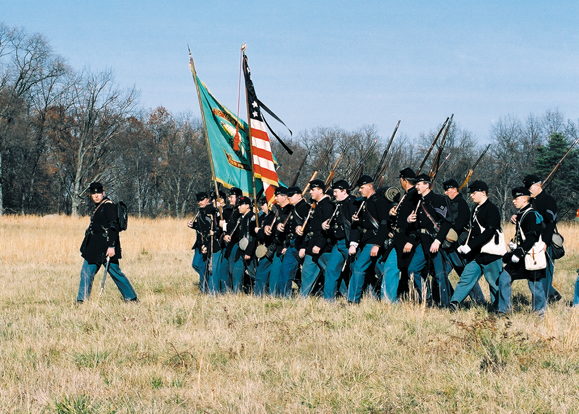
Thank you for your dedication and the history you preserve.